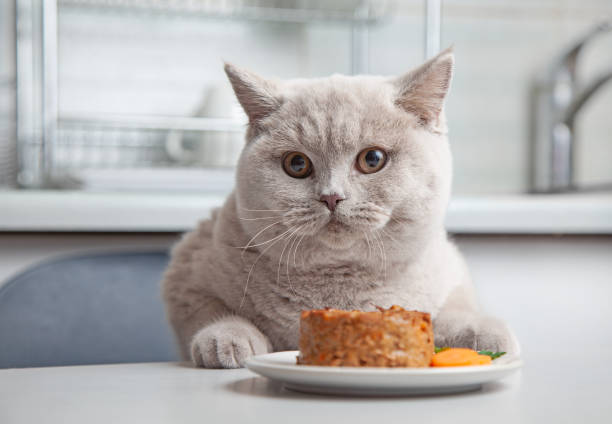Obesity in indoor cats is an increasingly common issue, often stemming from a sedentary lifestyle and dietary habits. For these feline companions, the right diet is not just about meeting nutritional needs—it’s about ensuring a healthy, balanced intake that aids in weight management.
Understanding Obesity in Indoor Cats
- Causes of Weight Gain: Indoor cats often lead less active lifestyles than their outdoor counterparts. Factors like overfeeding, high-calorie diets, and lack of physical activity contribute significantly to weight gain.
- Health Risks Associated with Obesity: Excess weight in cats can lead to several health problems, including diabetes, heart disease, and joint issues, all of which can significantly impact their quality of life and longevity.
Nutritional Requirements for Overweight Indoor Cats
- Calorie-Controlled Diets: For weight management, calorie-controlled diets are essential. These diets provide all the necessary nutrients without excess calories that can lead to weight gain.
- High-Protein, Low-Carbohydrate Formulas: Cats are carnivores by nature. Diets with higher protein content and fewer carbohydrates can help maintain muscle mass while encouraging fat loss.
- Fiber for Fullness: Foods with increased fiber content can help cats feel full for longer, reducing the urge to overeat and assisting in weight management.
Top Cat Food Brands for Weight Management
- Hill’s Science Diet Adult Perfect Weight: Formulated to help cats achieve a healthy weight.
- Pros: Clinically proven for weight management, contains prebiotic fibers.
- Cons: Includes grains, which may not suit all cats.
- Price: Around $45 for a 15-lb bag.
- Availability: Widely available in pet stores and online.
- Blue Buffalo Weight Control Natural Adult Dry Cat Food: A natural diet for weight control.
- Pros: Real chicken as the first ingredient, grain-free options available.
- Cons: Some formulas may be higher in carbohydrates.
- Price: Approximately $36 for a 15-lb bag.
- Availability: Most pet stores and online.
- Purina Pro Plan Focus Weight Management Cat Food: Tailored for weight loss in overweight cats.
- Pros: High in protein, promotes lean muscle mass during weight loss.
- Cons: Contains corn and wheat products.
- Price: About $40 for a 16-lb bag.
- Availability: Pet stores and online.
- Royal Canin Indoor Light 40: Specially made for indoor cats with a tendency to gain weight.
- Pros: Supports urinary health, reduces hairballs, and helps maintain a healthy weight.
- Cons: Higher price point, contains grains.
- Price: Around $50 for a 15-lb bag.
- Availability: Pet stores and online retailers.
- Iams Proactive Health Indoor Weight & Hairball Care: A balanced option for indoor cats.
- Pros: Aids in weight control and reduces hairballs.
- Cons: May contain chicken by-product meals.
- Price: Approximately $20 for a 7-lb bag.
- Availability: Easily found in most pet stores and online.
Feeding Strategies for Overweight Indoor Cats
- Portion Control and Feeding Frequency: It’s crucial to measure food portions and avoid free-feeding. Splitting the daily food intake into smaller, more frequent meals can prevent overeating.
- Slow Feeding Solutions: Slow feeder bowls or puzzle feeders can encourage slower eating, improving digestion and helping cats feel fuller.
**Additional Weight Management
Tips**
- Encouraging Physical Activity: Engage your cat in play with interactive toys, laser pointers, or even simple household items like paper balls. Daily play sessions can significantly increase their activity levels.
- Regular Health Check-ups: Regular vet visits are crucial to monitor your cat’s weight and overall health. They can also provide personalized dietary recommendations.
FAQs About Cat Food for Overweight Indoor Cats
- How do I transition my cat to a weight management diet? Gradually mix the new food with the existing one over a week, increasing the proportion of the new food while decreasing the old.
- Can my cat lose weight on dry food alone? Yes, if the dry food is specifically formulated for weight control and served in controlled portions. However, incorporating wet food can also help manage weight due to higher moisture content.
- What if my cat is constantly hungry on a weight management diet? Consult with your vet to ensure the diet is satisfying your cat’s hunger. Sometimes, increasing fiber or dividing the daily food into more frequent meals can help.
- Is grain-free food better for weight loss? Grain-free foods are not inherently better for weight loss but can be beneficial for cats with specific grain sensitivities.
- How fast should my cat lose weight? Rapid weight loss can be dangerous for cats. A slow, steady approach is safer, typically aiming for a loss of no more than 1-2% of body weight per week.
Conclusion
Choosing the right cat food is a critical step in managing weight for indoor cats. Along with a balanced, calorie-controlled diet, regular physical activity, and veterinary guidance are key components in maintaining a healthy weight. A comprehensive approach ensures your indoor cat stays healthy, active, and happy.

Jane Doe, a veterinarian with over 10 years of experience, combines her deep knowledge of animal health with a passion for pet welfare at PetsPonder.com. With a DVM degree and a commitment to the latest in veterinary science, Jane Doe offers reliable, compassionate advice to help pet owners make informed decisions for their furry companions.

Leave a Reply